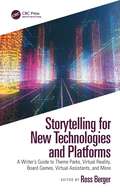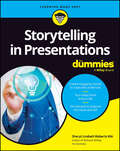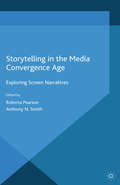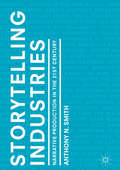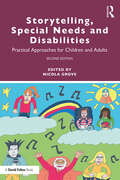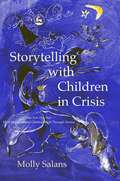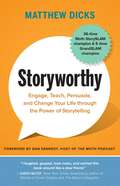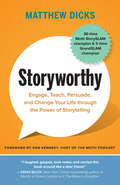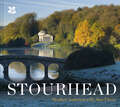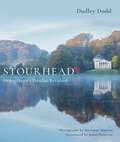- Table View
- List View
Storytelling for Film and Television: From First Word to Last Frame
by Ken DancygerStorytelling for Film and Television is a theory and practice book which offers a definitive introduction to the art of storytelling through writing, directing, and editing. Author Ken Dancyger provides a comprehensive explanation of the tools that underpin successful narrative filmmaking and television production. The book takes a unique approach by connecting the different phases of the creative process of film and television production. It shows how writing, directing, and editing all contribute to the process of storytelling and function together to advance the narrative goals of a screenplay, to tell the best story. A case study approach provides numerous examples of effectiveness and brings together the core areas of aesthetics and production to make these concepts more accessible. Case studies include classic and modern films, foreign films, limited and series television, with examples including Breaking Bad, Game of Thrones, The Revenant, and Son of Saul. This is the ideal text for film and television production students at all levels. It is written in a style which makes it accessible to anybody interested in learning more about the storytelling process and is written for a global audience addressing a global industry.
Storytelling for Film and Television: From First Word to Last Frame
by Ken DancygerStorytelling for Film and Television is a theory and practice book which offers a definitive introduction to the art of storytelling through writing, directing, and editing. Author Ken Dancyger provides a comprehensive explanation of the tools that underpin successful narrative filmmaking and television production. The book takes a unique approach by connecting the different phases of the creative process of film and television production. It shows how writing, directing, and editing all contribute to the process of storytelling and function together to advance the narrative goals of a screenplay, to tell the best story. A case study approach provides numerous examples of effectiveness and brings together the core areas of aesthetics and production to make these concepts more accessible. Case studies include classic and modern films, foreign films, limited and series television, with examples including Breaking Bad, Game of Thrones, The Revenant, and Son of Saul. This is the ideal text for film and television production students at all levels. It is written in a style which makes it accessible to anybody interested in learning more about the storytelling process and is written for a global audience addressing a global industry.
Storytelling for New Technologies and Platforms: A Writer’s Guide to Theme Parks, Virtual Reality, Board Games, Virtual Assistants, and More
by Ross BergerWant to know what it’s like to write for a theme park attraction? Or an interactive toy? Or for a virtual reality game? Wait – those tell stories? And there are jobs for people to write them? Thanks to technology, interactive products and live experiences can now engage us with memorable characters and exciting adventures that were once only destined for the cinema. Storytelling for New Technologies and Platforms: A Writer’s Guide to Theme Parks, Virtual Reality, Board Games, Virtual Assistants, and More is a handbook for writers, students, producers, teachers, scholars, career changers, early tech adopters, and just about anyone who loves story and technology. As a collection of articles from some of the best creative writers in their medium, this book will prepare content creators of tomorrow to tackle some of today's most exhilarating creative challenges found on a screen ... or off! Key Features: Expert advice from several industry professionals who have worked for some of the world’s biggest tech and interactive companies. Best practices that not only guide writers on how to apply their craft to new fields, but also prepare them for the common ambiguity they will find in corporate and start-up environments. Breakdown of platforms that shows how tech capabilities can fulfill content expectations and how content can fulfill tech expectations. Basic storytelling mechanics customized to today’s popular technologies, live experiences, and traditional game platforms.
Storytelling for New Technologies and Platforms: A Writer’s Guide to Theme Parks, Virtual Reality, Board Games, Virtual Assistants, and More
by Ross BergerWant to know what it’s like to write for a theme park attraction? Or an interactive toy? Or for a virtual reality game? Wait – those tell stories? And there are jobs for people to write them? Thanks to technology, interactive products and live experiences can now engage us with memorable characters and exciting adventures that were once only destined for the cinema. Storytelling for New Technologies and Platforms: A Writer’s Guide to Theme Parks, Virtual Reality, Board Games, Virtual Assistants, and More is a handbook for writers, students, producers, teachers, scholars, career changers, early tech adopters, and just about anyone who loves story and technology. As a collection of articles from some of the best creative writers in their medium, this book will prepare content creators of tomorrow to tackle some of today's most exhilarating creative challenges found on a screen ... or off! Key Features: Expert advice from several industry professionals who have worked for some of the world’s biggest tech and interactive companies. Best practices that not only guide writers on how to apply their craft to new fields, but also prepare them for the common ambiguity they will find in corporate and start-up environments. Breakdown of platforms that shows how tech capabilities can fulfill content expectations and how content can fulfill tech expectations. Basic storytelling mechanics customized to today’s popular technologies, live experiences, and traditional game platforms.
Storytelling for Virtual Reality: Methods and Principles for Crafting Immersive Narratives
by John BucherStorytelling for Virtual Reality serves as a bridge between students of new media and professionals working between the emerging world of VR technology and the art form of classical storytelling. Rather than examining purely the technical, the text focuses on the narrative and how stories can best be structured, created, and then told in virtual immersive spaces. Author John Bucher examines the timeless principles of storytelling and how they are being applied, transformed, and transcended in Virtual Reality. Interviews, conversations, and case studies with both pioneers and innovators in VR storytelling are featured, including industry leaders at LucasFilm, 20th Century Fox, Oculus, Insomniac Games, and Google. For more information about story, Virtual Reality, this book, and its author, please visit StorytellingforVR.com
Storytelling for Virtual Reality: Methods and Principles for Crafting Immersive Narratives
by John BucherStorytelling for Virtual Reality serves as a bridge between students of new media and professionals working between the emerging world of VR technology and the art form of classical storytelling. Rather than examining purely the technical, the text focuses on the narrative and how stories can best be structured, created, and then told in virtual immersive spaces. Author John Bucher examines the timeless principles of storytelling and how they are being applied, transformed, and transcended in Virtual Reality. Interviews, conversations, and case studies with both pioneers and innovators in VR storytelling are featured, including industry leaders at LucasFilm, 20th Century Fox, Oculus, Insomniac Games, and Google. For more information about story, Virtual Reality, this book, and its author, please visit StorytellingforVR.com
Storytelling für Museen: Herausforderungen und Chancen (Schriften zum Kultur- und Museumsmanagement)
by Andrea KramperGleichgültig, wie spannend ein Thema ist: Die Art der Vermittlung entscheidet darüber, ob es verstanden wird. Museen stehen dabei vor einem grundlegenden Dilemma: Sie müssen einerseits wissenschaftlichen Ansprüchen genügen, andererseits ihre Inhalte einer breiten Öffentlichkeit zugänglich machen. Eine Lösung für dieses Problem bietet Storytelling - eine Kommunikationstechnik, die Inhalte mit Hilfe von klassischen Erzählmustern vermittelt. Andrea Kramper beleuchtet anhand von Erkenntnissen aus der Museologie sowie den Kognitions- und Kommunikationswissenschaften die Herausforderungen und das Potenzial des Storytellings und zeigt, wie Museen hiervon profitieren können.
Storytelling für Museen: Herausforderungen und Chancen (Schriften zum Kultur- und Museumsmanagement)
by Andrea KramperGleichgültig, wie spannend ein Thema ist: Die Art der Vermittlung entscheidet darüber, ob es verstanden wird. Museen stehen dabei vor einem grundlegenden Dilemma: Sie müssen einerseits wissenschaftlichen Ansprüchen genügen, andererseits ihre Inhalte einer breiten Öffentlichkeit zugänglich machen. Eine Lösung für dieses Problem bietet Storytelling - eine Kommunikationstechnik, die Inhalte mit Hilfe von klassischen Erzählmustern vermittelt. Andrea Kramper beleuchtet anhand von Erkenntnissen aus der Museologie sowie den Kognitions- und Kommunikationswissenschaften die Herausforderungen und das Potenzial des Storytellings und zeigt, wie Museen hiervon profitieren können.
Storytelling in Luxury Fashion: Brands, Visual Cultures, and Technologies (Routledge Research in Design Studies)
by Amanda SikarskieThis book examines the ways in which luxury fashion brands use their heritage in their digital storytelling and marketing. With chapters from authors in China and Macau (PRC), India, Romania, Turkey, the United Kingdom, and the United States, covering British, Chinese, French, Japanese, Indian, Italian, and Turkish brands, this truly global collection is the first book of its kind devoted solely to the emerging study of digital heritage storytelling. This method of reaching potential consumers and perpetuating brand identity is a hugely important factor in the marketing of luxury brands and has yet to be studied comprehensively. The book will be of interest to scholars working in fashion studies, fashion history, design history, design studies, digital humanities, and fashion marketing.
Storytelling in Luxury Fashion: Brands, Visual Cultures, and Technologies (Routledge Research in Design Studies)
by Amanda SikarskieThis book examines the ways in which luxury fashion brands use their heritage in their digital storytelling and marketing. With chapters from authors in China and Macau (PRC), India, Romania, Turkey, the United Kingdom, and the United States, covering British, Chinese, French, Japanese, Indian, Italian, and Turkish brands, this truly global collection is the first book of its kind devoted solely to the emerging study of digital heritage storytelling. This method of reaching potential consumers and perpetuating brand identity is a hugely important factor in the marketing of luxury brands and has yet to be studied comprehensively. The book will be of interest to scholars working in fashion studies, fashion history, design history, design studies, digital humanities, and fashion marketing.
Storytelling in Motion: Cinematic Choreography and the Film Musical
by Jenny Oyallon-KoloskiHow do filmmakers guide viewer attention through the frame using the movement of bodies on screen? What do they seek to communicate with their cinematic choreography, and how were those choices shaped by the industrial conditions available to them? Storytelling in motion: Cinematic Choreography and the Film Musical demonstrates how figure movement can serve as a versatile strategy of meaning-making, particularly when filmmakers attend to the relationship between choreographed movement and film style. Using Franco-American film musicals as case studies, this book analyses the narrative and stylistic impact of figure movement in cinema and the subtle power of cinematic choreography, those moments when filmmakers deliberately combine the strengths of film style and organized figure movement to convey narrative meaning through motion. Cinematic choreography emphasizes musical conventions in Singin' in the Rain (Stanley Donen and Gene Kelly, 1952), prejudiced conflict in West Side Story (Jerome Robbins and Robert Wise, 1961), aesthetic play in Les Demoiselles de Rochefort (Jacques Demy, 1967), generic discomfort in Trois places pour le 26 (Jacques Demy, 1988), the politics of illness in Jeanne et le gar?on formidable (Olivier Ducastel and Jacques Martineau, 1998), and decision-making in La La Land (Damien Chazelle, 2016). Integrating vocabularies and analytical systems from Laban/Bartenieff Movement Studies, film studies, and related fields to parse cinematic figure movement on multiple formal levels, this book uses performative research methods from videographic criticism to show the poetic and oblique connections between films through videographic as well as written chapters. Storytelling in Motion centers the crucial material conditions needed to make figure movement a significant component of narrative filmmaking: time, money, rehearsal space, industrial support, and performers and crew with the necessary embodied and institutional knowledge. The films discussed tell a clear story of how cinematic choreography was used by French and American filmmakers to innovate storytelling through figure movement, inspired by their predecessors' aesthetics while working within differing industrial conditions.
Storytelling in Motion: Cinematic Choreography and the Film Musical
by Jenny Oyallon-KoloskiHow do filmmakers guide viewer attention through the frame using the movement of bodies on screen? What do they seek to communicate with their cinematic choreography, and how were those choices shaped by the industrial conditions available to them? Storytelling in motion: Cinematic Choreography and the Film Musical demonstrates how figure movement can serve as a versatile strategy of meaning-making, particularly when filmmakers attend to the relationship between choreographed movement and film style. Using Franco-American film musicals as case studies, this book analyses the narrative and stylistic impact of figure movement in cinema and the subtle power of cinematic choreography, those moments when filmmakers deliberately combine the strengths of film style and organized figure movement to convey narrative meaning through motion. Cinematic choreography emphasizes musical conventions in Singin' in the Rain (Stanley Donen and Gene Kelly, 1952), prejudiced conflict in West Side Story (Jerome Robbins and Robert Wise, 1961), aesthetic play in Les Demoiselles de Rochefort (Jacques Demy, 1967), generic discomfort in Trois places pour le 26 (Jacques Demy, 1988), the politics of illness in Jeanne et le gar?on formidable (Olivier Ducastel and Jacques Martineau, 1998), and decision-making in La La Land (Damien Chazelle, 2016). Integrating vocabularies and analytical systems from Laban/Bartenieff Movement Studies, film studies, and related fields to parse cinematic figure movement on multiple formal levels, this book uses performative research methods from videographic criticism to show the poetic and oblique connections between films through videographic as well as written chapters. Storytelling in Motion centers the crucial material conditions needed to make figure movement a significant component of narrative filmmaking: time, money, rehearsal space, industrial support, and performers and crew with the necessary embodied and institutional knowledge. The films discussed tell a clear story of how cinematic choreography was used by French and American filmmakers to innovate storytelling through figure movement, inspired by their predecessors' aesthetics while working within differing industrial conditions.
Storytelling in Participatory Arts with Young People: The Gaps in the Story (Palgrave Studies In Play, Performance, Learning, and Development)
by Catherine HeinemeyerThis book draws on the author’s experience as a storyteller, drama practitioner and researcher, to articulate an emerging dialogic approach to storytelling in participatory arts, educational, mental health, youth theatre, and youth work contexts. It argues that oral storytelling offers a rich and much-needed channel for intergenerational dialogue with young people.The book keeps theory firmly tethered to practice. Section 1, ‘Storyknowing’, traces the history of oral storytelling practice with adolescents across diverse contexts, and brings into clear focus the particular nature of the storytelling exchange and narrative knowledge. Section 2, ‘Telling Stories’, introduces readers to some of the key challenges and possibilities of dialogic storytelling by reflecting on stories from the author’s own arts-based practice research with adolescents, illustrating these with young people’s artistic responses to stories. Finally, section 3, ‘Story Gaps’, conceptualises dialogic storytelling by exploring three different ‘gaps’: the gap between storyteller and listener, the gaps in the story, and the gaps which storytellers can open up within institutions. The book includes chapters taking a special focus on storytelling in schools and in mental health settings, as well as guided reflections for readers to relate the issues raised to their own practice.
Storytelling in Presentations For Dummies
by Sheryl Lindsell-RobertsLearn to influence audiences with storyopia: Stories that take them on a journey from what is to what could be: Storytelling in Presentations For Dummies shows you how to develop and deliver a presentation through storytelling, keeping audience interested, and most importantly, making them heroes that take action towards change. You’ll learn how to cull stories from your own experiences, and before you know it, you’ll have more stories than Aesop has fables. You’ll learn about the latest presentation software, so you can integrate visuals into your presentations and avoid the dreaded “Death by PowerPoint.” You’ll also learn how to deal with challenging on-the-spot situations, deliver investor pitches and executive briefs, and present a paper at a conference. Additionally, find out how to deliver someone else’s content and make it your own. This book will help you level up anywhere you need to present information by mastering the art of savvy presentations—the most effective business communications tools of our time. Identify experiences that can be molded into stories that drive change. Prepare powerful openings to hook your audience right away whether delivering in person, online, or hybrid Have your audience get the most from your presentation with an effective call to action Prepare a storyboard, which is like a frame-by-frame roadmap, that will mesh together what you’ll show and what you’ll tell Leverage software like Canva, Prezi, and Storyboarder to tie your presentation together Enjoy the colorful 8-page mini-booklet, “Storytelling to Storyboarding”This Dummies guide is perfect for any professional who needs to present, and at some time all professionals do. It’s also for entrepreneurs who want to build community and grow their business, in addition to students who want to wow teachers and classmates.
Storytelling in Presentations For Dummies
by Sheryl Lindsell-RobertsLearn to influence audiences with storyopia: Stories that take them on a journey from what is to what could be: Storytelling in Presentations For Dummies shows you how to develop and deliver a presentation through storytelling, keeping audience interested, and most importantly, making them heroes that take action towards change. You’ll learn how to cull stories from your own experiences, and before you know it, you’ll have more stories than Aesop has fables. You’ll learn about the latest presentation software, so you can integrate visuals into your presentations and avoid the dreaded “Death by PowerPoint.” You’ll also learn how to deal with challenging on-the-spot situations, deliver investor pitches and executive briefs, and present a paper at a conference. Additionally, find out how to deliver someone else’s content and make it your own. This book will help you level up anywhere you need to present information by mastering the art of savvy presentations—the most effective business communications tools of our time. Identify experiences that can be molded into stories that drive change. Prepare powerful openings to hook your audience right away whether delivering in person, online, or hybrid Have your audience get the most from your presentation with an effective call to action Prepare a storyboard, which is like a frame-by-frame roadmap, that will mesh together what you’ll show and what you’ll tell Leverage software like Canva, Prezi, and Storyboarder to tie your presentation together Enjoy the colorful 8-page mini-booklet, “Storytelling to Storyboarding”This Dummies guide is perfect for any professional who needs to present, and at some time all professionals do. It’s also for entrepreneurs who want to build community and grow their business, in addition to students who want to wow teachers and classmates.
Storytelling in the Media Convergence Age: Exploring Screen Narratives
by Roberta Pearson Anthony N. SmithWhy do screen narratives remain so different in an age of convergence and globalisation that many think is blurring distinctions? This collection attempts to answer this question using examples drawn from a range of media, from Hollywood franchises to digital comics, and a range of countries, from the United States to Japan
Storytelling Industries: Narrative Production in the 21st Century
by Anthony N. SmithThis book shows how the unique characteristics of traditionally differentiated media continue to determine narrative despite the recent digital convergence of media technologies. The author argues that media are now each largely defined by distinctive industrial practices that continue to preserve their identities and condition narrative production. Furthermore, the book demonstrates how a given medium’s variability in institutional and technological contexts influences diverse approaches to storytelling. By connecting US film, television, comic book and video game industries to their popular fictional characters and universes; including Star Wars, Batman, Game of Thrones and Grand Theft Auto; the book identifies how differences in industrial practice between media inform narrative production. This book is a must read for students and scholars interested in transmedia storytelling.
Storytelling Industries: Narrative Production in the 21st Century
by Anthony N. SmithThis book shows how the unique characteristics of traditionally differentiated media continue to determine narrative despite the recent digital convergence of media technologies. The author argues that media are now each largely defined by distinctive industrial practices that continue to preserve their identities and condition narrative production. Furthermore, the book demonstrates how a given medium’s variability in institutional and technological contexts influences diverse approaches to storytelling. By connecting US film, television, comic book and video game industries to their popular fictional characters and universes; including Star Wars, Batman, Game of Thrones and Grand Theft Auto; the book identifies how differences in industrial practice between media inform narrative production. This book is a must read for students and scholars interested in transmedia storytelling.
Storytelling, Special Needs and Disabilities: Practical Approaches for Children and Adults
by Nicola GroveNow in a fully revised and updated second edition, this innovative and wide-ranging book shows how storytelling can open new worlds for individuals with special educational needs and disabilities. Providing a highly accessible combination of theory and practice, the contributors to this book define their own approaches to inclusive storytelling, describing the principles and theory that underpin their practice, whilst never losing sight of the joy at the heart of their work. Topics include therapeutic storytelling; language and communication; interactive and multi-sensory storytelling; and technology. Each chapter includes top tips, and signposts further training for practitioners who want to start using stories in their own work, making this book a crucial and comprehensive guide to storytelling practice with diverse learners. This new edition: · has been fully updated to reflect the way in which this field of storytelling has grown and developed · uses a broad range of chapters, structured in a way that guides the reader through the conceptualisation of a storytelling approach towards its practical application · includes an additional chapter, sharing the lived experiences of storytellers who identify as having a disability. Full of inspiring ideas to be used with people of all ages and with a range of needs, this book will be an invaluable tool for education professionals, as well as therapists, youth workers, counsellors and theatre practitioners working in special education.
Storytelling, Special Needs and Disabilities: Practical Approaches for Children and Adults
by Nicola GroveNow in a fully revised and updated second edition, this innovative and wide-ranging book shows how storytelling can open new worlds for individuals with special educational needs and disabilities. Providing a highly accessible combination of theory and practice, the contributors to this book define their own approaches to inclusive storytelling, describing the principles and theory that underpin their practice, whilst never losing sight of the joy at the heart of their work. Topics include therapeutic storytelling; language and communication; interactive and multi-sensory storytelling; and technology. Each chapter includes top tips, and signposts further training for practitioners who want to start using stories in their own work, making this book a crucial and comprehensive guide to storytelling practice with diverse learners. This new edition: · has been fully updated to reflect the way in which this field of storytelling has grown and developed · uses a broad range of chapters, structured in a way that guides the reader through the conceptualisation of a storytelling approach towards its practical application · includes an additional chapter, sharing the lived experiences of storytellers who identify as having a disability. Full of inspiring ideas to be used with people of all ages and with a range of needs, this book will be an invaluable tool for education professionals, as well as therapists, youth workers, counsellors and theatre practitioners working in special education.
Storytelling with Children in Crisis: Take Just One Star - How Impoverished Children Heal Through Stories (PDF)
by Molly Salans'This book looks at the benefits to children of listening to fairy tales, a selection of which are provided, and creating their own. I found Storytelling with Children in Crisis thought provoking and I am glad I was able to put into practice some of its ideas.' - Counselling Children and Young People Journal 'Describing home-based therapeutic work in real-life chaotic families, this book has relevance to anyone working with children and families. What is most helpful is the author's readiness to discuss her own doubts and vulnerabilities.' - Community Care Molly Salans has been a storyteller for many years, visiting children in deprived areas who have depression, ADHD and behavioral problems caused by poverty, absent fathers, depressed mothers, run-down schools and violence. Describing her therapy sessions as they happened, Molly Salans puts the children in the context of their lives and recounts her sessions, the folk and fairy stories she told and the ones they developed themselves. In doing so, she shows how storytelling and listening, thinking about characters in the stories and talking about alternative endings inspires the imagination, compassion and way of thinking needed to cope with such emotionally difficult lives. This remarkable book includes over fifteen original children's drawings and reveals the methodology Molly uses to help heal these children and their families, making it essential for all those involved in therapy and in storytelling.
Storyworthy: Engage, Teach, Persuade, And Change Your Life Through The Power Of Storytelling (PDF)
by Matthew Dicks Dan KennedyWhether we realise it or not, we are always telling stories. On a first date or job interview, in a sales presentation or therapy appointment, with family or friends, we are constantly narrating events and interpreting emotions and actions. In so doing, we make choices about what to emphasize and what to leave out. We frame and explain in order to amuse, rationalize, or just plain vent. The author, acclaimed for his storytelling on stages, the radio, and in novels including Memoirs of an Imaginary Friend, is also an award-winning teacher. His wonderfully straightforward and engaging tips and techniques for constructing, telling, and polishing any story show that anyone can learn to be an appealing storyteller; that everyone has something story worthy to express; and, perhaps most importantly, that the act of creating and telling a tale is a powerful way of understanding and enhancing one's own life.
Storyworthy: Engage, Teach, Persuade, And Change Your Life Through The Power Of Storytelling
by Matthew Dicks Dan Kennedy"A 30-time StorySLAM champion shows readers how to improve their storytelling skills, and how doing so can improve their relationships, careers, and overall well-being"--.
Stourhead
by Stephen AndertonA beautifully illustrated celebration of Stourhead, featuring the legendary Georgian landscape garden in glorious autumn colour with essays by head gardener Alan Power.
Stourhead: Henry Hoare's Paradise Revisited
by Dudley Dodd'Brings both house and garden vividly to life... A magnificent achievement' Gardens Illustrated'A finely crafted work... it is an important record of the history of one of the country's most splendid estates' The English GardenThe Palladian house of Stourhead, in Wiltshire, occupies a plateau above the confluence of three valleys. When you cross the south lawn and descend the tree-hung slopes, you glimpse a lake adorned with classical temples. Continue and you will find an allegorical grotto; a gothick hideaway; a Pantheon of demi-gods and, on high, a deserted temple to Apollo. To the west Alfred's Tower commands views over three counties, a gaunt landmark to English monarchy and patriotism.This is how in Georgian times Henry Hoare – known as Henry the Magnificent – would have explored the garden he designed. Generations of the Hoare family, bankers who combined service with enlightened patronage and philanthropy, have developed and cultivated the garden at Stourhead, and for many its breathtaking vistas are paradise.Dudley Dodd charts the owners of Stourhead and the history of the landscape, house and art collection. He describes how flights of folly, individual flair, taste and careful stewardship have nurtured a national treasure, which is among the finest English landscape gardens and, since 1946, a jewel of The National Trust. The stunning new pictures by the renowned photographer Marianne Majerus provide an up to date record of this enduring Elysium.

